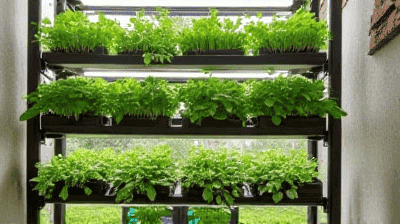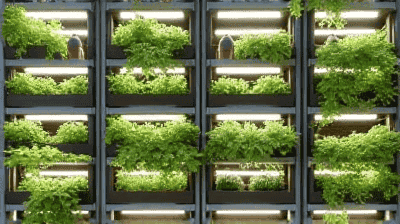
As the world continues to urbanize, with projections suggesting that nearly 70 percent of the global population will live in cities by 2050, the challenge of providing sustainable food sources has become increasingly pressing. Urban areas often face limited space and resources, leading to creative solutions that prioritize sustainability and food security. One innovative response to these challenges is urban farming, particularly in the form of vertical farming.
Urban farming refers to the practice of cultivating, processing, and distributing food in and around urban areas. This farming approach encompasses a diverse range of methods, including community gardens, rooftop farms, indoor farms, and vertical farming systems. Key characteristics of urban farming include:
Local Food Production: Urban farming reduces the distance food travels from farm to table, minimizing carbon emissions associated with transportation.
Use of Space: Urban farms maximize limited space through innovative designs, including vertical growing systems and multi-layered cropping.
Community Engagement: Urban farming initiatives often involve local residents, fostering a sense of community and promoting connections between people and their food sources.
Sustainable Practices: Many urban farms adopt organic and sustainable practices, focusing on minimizing environmental impact while maximizing resource efficiency.
Urban farming offers numerous social, economic, and environmental benefits, including:
Food Security: By increasing local food production, urban farming can enhance food security for city residents, particularly in food deserts where access to fresh produce is limited.
Environmental Sustainability: Urban farms can improve air quality, enhance biodiversity, and contribute to urban ecosystems by integrating green spaces into cities.
Community Building: Urban farms promote social cohesion by bringing people together around a shared goal—producing food. This can strengthen community ties and foster a sense of belonging.
Economic Opportunities: Urban farms can create jobs and stimulate local economies by providing fresh produce to markets, restaurants, and consumers.
Education and Awareness: Urban farming initiatives often include educational programs that raise awareness about food systems, nutrition, and sustainable agricultural practices.

Vertical farming is a method of growing crops in stacked layers or vertically inclined surfaces, often utilizing controlled-environment agriculture (CEA) techniques. This innovative approach to agriculture allows farmers to produce food in urban settings where land is scarce. Key characteristics of vertical farming include:
Stacked Growing Systems: Crops are grown in layers, often in hydroponic or aquaponic systems, allowing for maximum space utilization.
Controlled Environments: Vertical farms typically employ technologies that regulate temperature, humidity, light, and nutrient levels, creating optimal growing conditions year-round.
Resource Efficiency: Vertical farming methods can significantly reduce water usage compared to traditional agriculture, as they often employ recirculating water systems.
Year-Round Production: By controlling environmental conditions, vertical farms can produce food throughout the year, independent of seasonal fluctuations.
Vertical farming presents several advantages that make it an attractive solution for urban food production:
Space Optimization: Vertical farms make use of urban spaces, such as rooftops, abandoned buildings, and repurposed warehouses, maximizing food production in limited areas.
Reduced Transportation Emissions: By growing food close to where it will be consumed, vertical farming minimizes the carbon footprint associated with transporting food long distances.
Higher Yields: The ability to grow crops year-round and in controlled environments can lead to significantly higher yields per square foot compared to traditional farming.
Less Pesticide Use: Many vertical farming systems use organic practices or integrated pest management strategies, reducing the need for synthetic pesticides and herbicides.
Local Resilience: Vertical farms contribute to urban resilience by providing fresh food sources in times of crisis, such as natural disasters or pandemics.
The concept of vertical farming is not entirely new. Historical agrarian practices such as terrace farming and the Hanging Gardens of Babylon highlight the long-standing relationship between agriculture and vertical space utilization. However, it is only in recent decades that vertical farming has gained prominence, driven by urbanization, technological advancements, and growing awareness of food security and environmental sustainability issues.
The modern vertical farming movement emerged in the early 2000s, with pioneers like Dr. Dickson Despommier advocating for urban agriculture as a solution to the challenges posed by urbanization. Advancements in hydroponics, aeroponics, and controlled-environment agriculture have further propelled the growth of vertical farming.
Around the world, innovative urban vertical farms are making waves in the fight for sustainable food production. Here are some notable examples:
Vertical Harvest (Jackson, Wyoming, USA): This vertically integrated farm produces fresh vegetables and flowers in a hydroponic system while providing job opportunities for individuals with disabilities. The farm emphasizes community engagement and access to fresh food.
Sky Green (Singapore): This innovative vertical farm utilizes a patented "A-frame" system, allowing for efficient sunlight capture and water recycling. Located in one of the world's densest cities, Sky Green produces vegetables while minimizing land use and environmental impact.
Growing Underground (London, UK): Situated in a former underground station, Growing Underground employs hydroponic technology to produce greens and herbs. By utilizing an abandoned space, this farm demonstrates the potential of urban infrastructure for food production.
Farm.One (New York City, USA): Farm.One is an indoor vertical farm that specializes in growing rare herbs and microgreens for local chefs and restaurants. This model showcases the potential of vertical farming to cater to niche markets while promoting local food.
Infarm (Berlin, Germany): Infarm is a tech-driven urban vertical farming company that installs modular indoor farms in grocery stores and restaurants. This approach allows consumers to access hyper-local produce while reducing the carbon footprint associated with food transportation.

Vertical farming relies heavily on innovative technologies to optimize production and ensure efficiency. Some key technologies include:
Hydroponics and Aeroponics: These soil-less farming methods use nutrient-rich water solutions to grow crops. Hydroponics involves submerging the roots in nutrient-rich water, while aeroponics suspends the plants in air and mists the roots with nutrients.
LED Lighting: Advanced lighting systems, particularly LED technology, provide the specific light wavelengths required for plant growth, optimizing energy use and reducing heat output.
Climate Control Systems: Vertical farms utilize HVAC systems and sensors to monitor and control environmental conditions, such as temperature, humidity, and CO2 levels, ensuring optimal growing conditions year-round.
Automation and Robotics: Many vertical farms employ automation and robotics for tasks such as planting, harvesting, and packaging, improving efficiency and reducing labor costs.
Data Analytics: Vertical farms often implement data-driven decision-making through the use of software and sensors that track plant growth, health, and environmental conditions, allowing for precise management of resources.
Urban farming initiatives foster community engagement by bringing residents together around shared goals and interests. Key aspects of community involvement in urban farming include:
Community Gardens: Community gardens provide shared spaces for residents to grow their food, encouraging cooperation, social interaction, and skill-building.
Education Programs: Many urban farms offer educational workshops and programs that teach residents about sustainable agriculture, nutrition, and food systems, empowering individuals to take control of their food sources.
Volunteer Opportunities: Urban farms often rely on volunteers to help with planting and maintenance, providing hands-on experiences for community members and fostering connections to the local food system.
Local Food Networks: Urban farms can strengthen local food networks by collaborating with restaurants, grocery stores, and farmer's markets to create a more resilient local economy.
Urban farming plays a crucial role in addressing food deserts—areas with limited access to fresh, healthy food options. By implementing vertical farms in these neighborhoods, cities can increase food access and improve community health outcomes. Initiatives may include:
Partnerships with Local Organizations: Urban farms can collaborate with local nonprofits and community organizations to distribute fresh produce to underserved populations.
Sliding Scale Pricing: Many urban farms adopt sliding scale pricing models that make fresh produce affordable for low-income households while ensuring the economic sustainability of the farm.
Mobile Markets: Urban farms can establish mobile markets that bring fresh produce directly to neighborhoods with limited access to grocery stores, enhancing food access.

Urban and vertical farming help reduce the carbon footprint associated with food production by minimizing transportation emissions, promoting energy-efficient practices, and reducing waste. Some key environmental benefits include:
Lower Transportation Emissions: By growing food closer to where it will be consumed, urban farms can significantly reduce transportation-related emissions.
Water Conservation: Vertical farming methods often employ recirculating water systems that can reduce water usage by up to 90 percent compared to traditional agriculture.
Waste Reduction: Urban farms often utilize food waste and compost to enrich the soil, diverting organic waste from landfills and minimizing greenhouse gas emissions associated with waste decomposition.
Urban Heat Island Mitigation: Incorporating green spaces and urban farms can help mitigate the urban heat island effect, lowering temperatures in densely populated areas and improving overall urban resilience.
Urban agriculture can create habitats for wildlife and foster biodiversity within urban environments. Key benefits include:
Pollinator Habitats: Urban farms can provide essential habitats for pollinators like bees and butterflies, supporting overall ecosystem health and biodiversity.
Soil Health: Sustainable practices used in urban farms, such as crop rotation, organic amendments, and cover cropping, enhance soil health and promote biodiversity in soil organisms.
Green Spaces: Urban farms contribute to the creation of green spaces within cities, improving residents' quality of life and offering recreational opportunities.
While urban farming offers significant benefits, challenges such as space constraints and infrastructure limitations can hinder its growth. Some considerations include:
Zoning Regulations: Local zoning laws may restrict agricultural activities in urban areas, creating barriers for urban farming initiatives.
Access to Land: Competition for urban land can drive up costs, making it difficult for urban farms to secure affordable space for production.
Infrastructure Needs: Vertical farming requires significant investment in specialized infrastructure, which can pose financial challenges for startup operations.
While urban farming has the potential for economic sustainability, various factors can impact its financial success:
High Initial Costs: The setup costs for vertical farming facilities can be substantial due to technology, equipment, and infrastructure needs, making it difficult for new farms to become profitable.
Market Competition: Urban farms may face competition from established grocery chains and food suppliers, making it challenging to carve out a market niche.
Consumer Education: Educating consumers about the benefits of urban farming and attracting loyal customers can take time and effort.
Urban farming must also contend with climate-related challenges:
Extreme Weather Events: Urban farms can be vulnerable to flooding, heatwaves, and other climate-related events that can disrupt production and impact yields.
Water Supply Vulnerability: Urban farms often rely on municipal water sources, which may be subject to scarcity and fluctuating availability during droughts.
As urban farming evolves, several innovations and trends are shaping its future:
Integration of Technology: Continued advancements in technology will drive efficiencies in urban and vertical farming, allowing for more precise resource management and higher yields.
Resilient Practices: Urban farms will increasingly adopt practices that enhance climate resilience, including rainwater harvesting, water recycling, and soil health improvements.
Policy Advocacy: Advocating for supportive policies and zoning regulations will be essential for removing barriers to urban farming and fostering its growth.
Public-Private Partnerships: Collaborations between government entities, nonprofits, and private businesses can provide the resources and support needed for urban farms to thrive.
The rise of urban farming, particularly in the form of vertical farming, presents an innovative solution to the challenges of food production in rapidly urbanizing environments. By maximizing limited space, reducing transportation emissions, and fostering community engagement, urban farming systems can significantly contribute to sustainable food practices. As cities continue to explore urban agriculture, the integration of technology, community involvement, and environmental stewardship will be crucial for ensuring that urban farms thrive and help feed the world sustainably.
By embracing the potential of urban farming, cities can pave the way for a more resilient food future, where local communities have access to fresh, healthy food while minimizing their environmental impact. As we move forward, the continued support for urban farming will be essential for building a sustainable and equitable food system that meets the needs of all city residents.